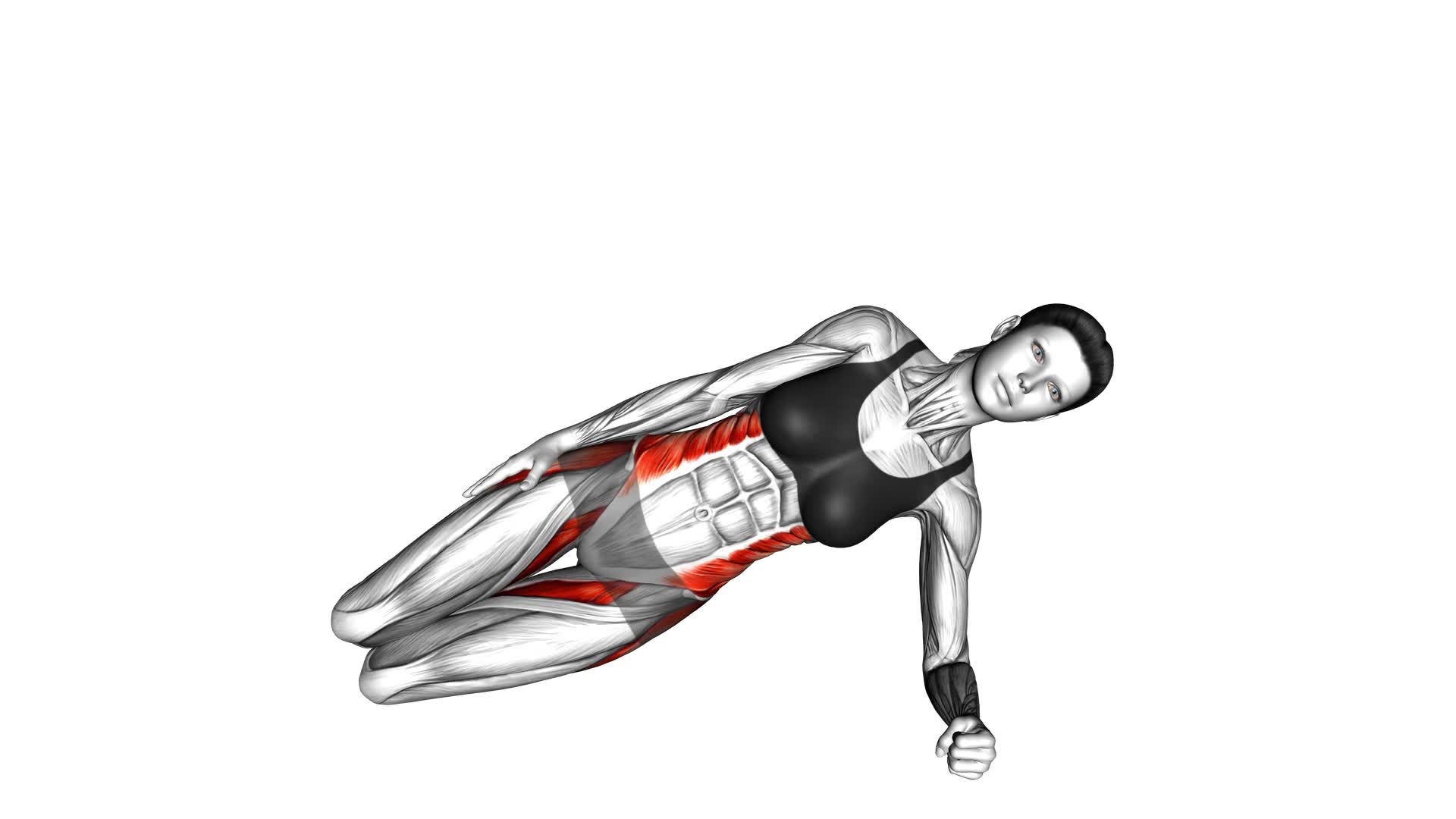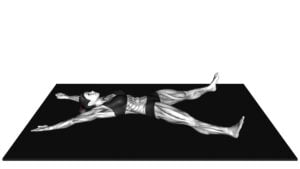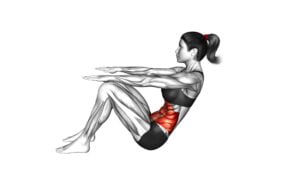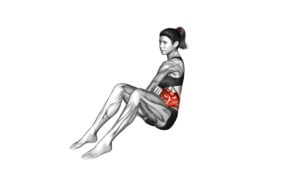Side Plank (beginner) (female) – Video Exercise Guide & Tips

In this video exercise guide, you'll discover the benefits of the Side Plank and learn proper form and technique.
Watch This Exercise Video
If you're a beginner looking to strengthen your core, this workout is perfect for you. We'll also show you modifications to make it more accessible.
Avoid common mistakes and get tips for progression and variation.
Get ready to feel the burn and get stronger with this beginner-friendly Side Plank workout.
Let's get started!
Key Takeaways
- Side plank engages the core and strengthens obliques
- Proper form and technique include aligning the body with shoulder directly above elbow and squeezing glutes for stability
- Modifications for beginners include bent knee side plank and side plank against a wall
- Progression and variation can be achieved by incorporating different progression levels and adding variations like lifting top leg or adding rotation
Benefits of the Side Plank
To fully engage your core and strengthen your obliques, the side plank offers a highly effective exercise option. Side plank variations are great core strengthening exercises that target not only your abs but also your oblique muscles. By performing the side plank, you can improve your stability, balance, and overall core strength.
One variation of the side plank is the regular side plank, where you start by lying on your side and propping yourself up on your forearm. Lift your hips off the ground, creating a straight line from your head to your toes, and hold this position for a set amount of time.
Another variation is the side plank with leg lift, where you lift your top leg while maintaining the side plank position. This adds an extra challenge to your core muscles and increases the engagement of your obliques.
Incorporating side plank variations into your workout routine can help you build a strong and stable core. These exercises not only target your abs and obliques but also engage other muscles in your body, such as your shoulders, hips, and glutes.
Remember to perform each variation with proper form and gradually increase the difficulty as you get stronger.
Proper Form and Technique
Start by positioning yourself on your side and propping yourself up on your forearm to initiate the proper form and technique for the side plank exercise. This exercise is important for building core strength and improving stability and balance.
Here are four key points to keep in mind:
- Align your body: Make sure your shoulder is directly above your elbow, and your body forms a straight line from head to toe. Engage your core muscles to maintain this alignment throughout the exercise.
- Squeeze your glutes: To increase stability and balance, engage your glute muscles by squeezing them together. This will help prevent your hips from sagging or rotating during the side plank.
- Breathe deeply: Inhale deeply through your nose and exhale through your mouth throughout the exercise. This will help you maintain focus and stability.
- Start with a modified version: If you're a beginner, it's recommended to start with a modified side plank by bending your knees and resting on your bottom knee instead of your feet. As you build strength and confidence, you can progress to the full side plank.
Modifications for Beginners
Ease into the side plank exercise by modifying it to suit your beginner level. If you find the traditional side plank too challenging, there are modification tips that can help you build strength and stability gradually.
One modification is to start with a bent knee side plank. Instead of keeping both legs straight, you can bend the bottom knee and rest it on the ground. This will provide extra support and make it easier to maintain the position.
Another modification is to perform the side plank against a wall. By placing your forearm against the wall instead of the floor, you can reduce the intensity of the exercise while still targeting the same muscles.
Additionally, you can try a forearm plank instead of a full side plank. This variation allows you to focus on core strength without the added difficulty of balancing on one arm.
These beginner friendly exercises are great starting points to gradually work your way up to the full side plank. Remember to listen to your body and progress at a pace that feels comfortable for you.
Common Mistakes to Avoid
As you progress in your side plank exercise, there are common mistakes to avoid that can hinder your form and effectiveness. By being aware of these mistakes, you can ensure that you're maximizing the benefits of the side plank while minimizing the risk of injury.
Here are four common mistakes to avoid:
- Allowing your hips to sag: One of the key muscles targeted in the side plank is the obliques. To effectively engage these muscles, it's important to keep your body in a straight line from your head to your feet. Avoid letting your hips drop towards the ground, as this can put strain on your lower back.
- Placing too much weight on your supporting arm: While it's natural to rely on your arm for support, make sure you aren't putting too much weight on it. This can cause undue stress on your shoulder joint. Instead, focus on distributing your weight evenly between your arm and your feet.
- Holding your breath: It's important to maintain a steady breathing pattern throughout the exercise. Holding your breath can lead to increased tension in your body and may prevent you from maintaining proper form.
- Neglecting proper alignment: Pay attention to the alignment of your body during the side plank. Ensure that your shoulder is stacked directly above your elbow and that your hips are stacked on top of each other. This will help you maintain stability and prevent any unnecessary strain on your joints.
Tips for Progression and Variation
What are some ways you can progress and vary your side plank exercise?
To continue challenging yourself and making progress with your side plank, there are a few options you can explore.
One way to increase the difficulty is by incorporating different progression levels. For example, you can start by performing the side plank on your knees instead of your feet. As you build strength, you can gradually transition to a full side plank on your feet.
Another option is to add variations to the exercise. You can try lifting your top leg while holding the side plank position, or you can add a rotation by reaching your top arm towards the ceiling and then bringing it back down.
Additionally, you can utilize equipment to further challenge your side plank. A stability ball or a Bosu ball can add an unstable surface, forcing your core muscles to work even harder to maintain stability.
With these progression levels and equipment options, you can continue to challenge yourself and make progress with your side plank exercise.
Frequently Asked Questions
How Long Should I Hold the Side Plank Exercise?
You should hold the side plank exercise for as long as you can maintain proper form without straining yourself.
It's important to listen to your body and start with a shorter duration if you're a beginner.
If you find it challenging, you can modify the side plank by dropping your bottom knee to the ground or by using a wall for support.
Can Side Planks Help Reduce Waist Size?
Side planks are a great addition to your weight loss program. They can help reduce waist size by engaging and toning your abdominal muscles. By regularly incorporating side planks into your exercise routine, you'll strengthen your core and improve overall stability.
This exercise targets the obliques, which are the muscles responsible for waist definition. So, if you're looking to slim down your waist and achieve a toned midsection, side planks are definitely worth including in your workout routine.
Are There Any Alternatives to Side Planks for Beginners?
If you're a beginner and looking for alternatives to side planks, there are a few options you can try.
One modification for side plank exercises is to perform a knee-supported side plank, where you rest your bottom knee on the ground for added stability.
Another alternative is a side plank variation using a stability ball or a yoga block for support.
These modifications can help you build strength and stability in your core while still targeting the same muscle groups as traditional side planks.
How Often Should I Include Side Planks in My Workout Routine?
To determine the frequency of side planks in your workout routine, consider your fitness goals and overall strength level.
Side planks are effective for building core strength and stability.
Incorporating them 2-3 times a week is a good starting point.
As you progress, you can increase the frequency or try different variations of side planks to challenge yourself further.
Remember to listen to your body and give yourself rest days to avoid overtraining.
Can Side Planks Help Improve Posture?
Side planks can definitely help improve your posture. By engaging your core muscles, side planks promote stability and alignment in your spine, which in turn can lead to better posture.
Additionally, side plank variations can target specific muscles that are responsible for maintaining good posture, such as the obliques and the muscles in your lower back.
Including side planks in your workout routine regularly can be a great way to strengthen your core and improve your overall posture.
Conclusion
In conclusion, the side plank is a beneficial exercise for beginners, particularly females, as it strengthens the core and improves stability.
It's important to maintain proper form and technique to maximize the benefits and minimize the risk of injury.
Beginners can modify the exercise to suit their fitness level and should avoid common mistakes such as sagging hips or over-arching the lower back.
By following these tips, individuals can progress and vary their side plank routine for continued improvement.

Author
Years ago, the spark of my life’s passion ignited in my mind the moment I stepped into the local gym for the first time. The inaugural bead of perspiration, the initial endeavor, the very first surge of endorphins, and a sense of pride that washed over me post-workout marked the beginning of my deep-seated interest in strength sports, fitness, and sports nutrition. This very curiosity blossomed rapidly into a profound fascination, propelling me to earn a Master’s degree in Physical Education from the Academy of Physical Education in Krakow, followed by a Sports Manager diploma from the Jagiellonian University. My journey of growth led me to gain more specialized qualifications, such as being a certified personal trainer with a focus on sports dietetics, a lifeguard, and an instructor for wellness and corrective gymnastics. Theoretical knowledge paired seamlessly with practical experience, reinforcing my belief that the transformation of individuals under my guidance was also a reflection of my personal growth. This belief holds true even today. Each day, I strive to push the boundaries and explore new realms. These realms gently elevate me to greater heights. The unique combination of passion for my field and the continuous quest for growth fuels my drive to break new ground.



